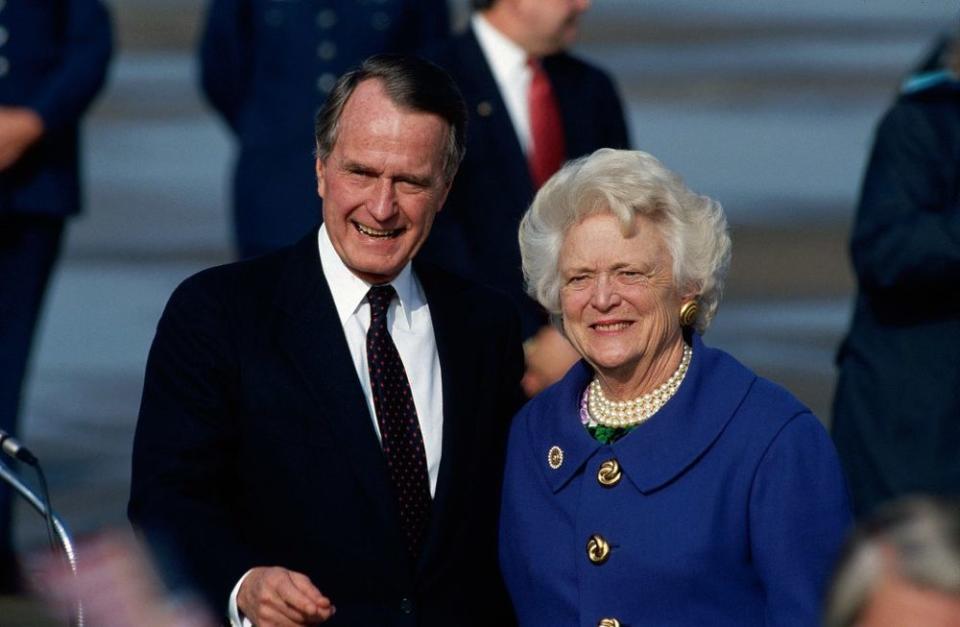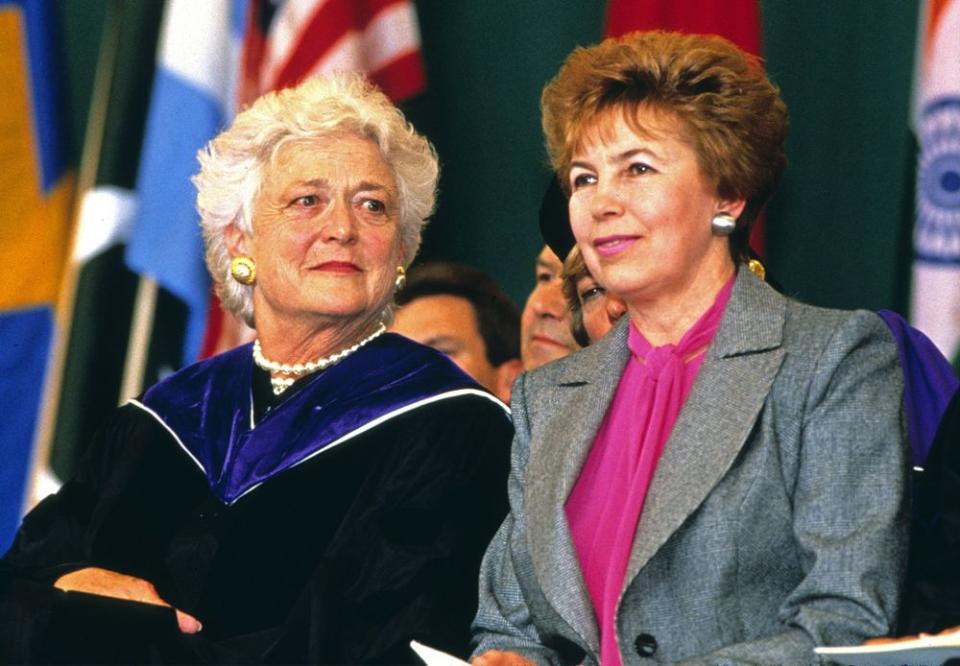'The Most Underestimated First Lady of Modern Times': How Barbara Bush Left a Political Legacy All Her Own

The cliche almost writes itself: Barbara Bush, with her white hair and pearls, often appeared to be the American ideal of a home-making grandmother, a woman who supported one president in marriage and raised another.
There is some truth to that idea. But only some.
“In my view, she stands as the most underestimated First Lady of modern times. And perhaps the most interesting,” Susan Page writes in
, a biography of Bush published this month.
Page’s book includes five interviews with Bush before she died last year, as well as access to her lifelong diaries. It’s only the latest example to lay out the ways in which Bush, though never a political candidate, was nonetheless a prominent political figure.
Bush, who died one year ago at 92, helped shape husband George H. W. Bush‘s policies and worldview — and, by extension, American life.
Page writes: “I discovered that there was more about Barbara Bush, and her role in some of the most important events of our age, than I would have even guessed.”
Educating the World
In the early days of HIV/AIDS, a time when those with the deadly virus were widely shunned, Mrs. Bush cradled babies who had been abandoned after their diagnosis and visited ailing patients in the hospital. It was notable compassion from the first lady and it was forged from decades-old grief: the death of young daughter Robin, from cancer, in 1953.
“She never forgot what happened when her three-year-old daughter, being treated for leukemia, came home to Midland from Sloan Kettering for one last visit,” Page writes in The Matriarch.
“When Robin got sick, people avoided us like the plague. Even my close friends,’ ” Bush told Page years later, “her voice marked more by sorrow than anger.”
When her husband was the vice president, Mrs. Buch would come home from visits with AIDS patients or from time spent with the homeless and tell him all about it.
He was then considered “behind the curve” on those and other issues, such as civil rights, according to TIME. The magazine described Mrs. Bush as being “instrumental” in her husband appointing a black person to his cabinet.
While pushing to increase literacy is what Mrs. Bush is best remembered for, she also helped normalize Soviet-American relations and the treatment of HIV/AIDS patients. In 1990 her husband banned discrimination against those with the virus as part of the Americans With Disabilities Act.
As TIME detailed in 1989, “It was Barbara‘s visits to AIDS hospitals in Harlem that nudged her husband into endorsing additional federal funds for fighting the disease when the Reagan Administration was still balking.”
“Similarly, after an early debate when her husband brushed aside a question about the homeless with boilerplate about housing,” according to TIME, “Barbara exhorted him to make homelessness a campaign issue. ‘She really talked hard at him,’ said an aide, ‘and rode him until he got it right.’ ”
RELATED VIDEO: George W. Bush Cries During Emotional Eulogy of Father George H. W.
Mrs. Bush’s behavior toward HIV and AIDS patients was markedly warmer after years of disdain and disinterest from Reagan administration officials, and her husband made some progress in helping patients. But activists have long said neither he nor his predecessor did nearly enough.
“If one was being charitable one could say it was a mixed legacy, but in truth it was a bad legacy of leadership,” Urvashi Vaid, a former head of the National Gay and Lesbian Task Force, told the New York Times last year. “He did not lead on AIDS.”
Still, Mrs. Bush’s high profile and public actions taught compassion at a time when a diagnosis alienated victims from family, friends and proper medical care.
“People often ask whether the famous picture of Barbara Bush cuddling one of the babies at our care home for children with HIV/AIDS was staged by White House photographers or handlers,” the founders of Grandma’s House, a residential care home for children with HIV/AIDS, wrote in The Washington Post days after Mrs. Bush’s death.
“It was not,” co-founders Debbie Tate and Joan McCarley recalled. “It was a caring grandmother’s genuine instinct to comfort and soothe a sick baby.”
They added: “At the height of the HIV/AIDS crisis, she [Mrs. Bush] single-handedly educated the world, saying that it is okay to support places such as Grandma’s House.”

‘The Toughest Issue’
The Bushes split on abortion — if only, in some ways, by necessity.
In 1980, when President Bush was not yet in the White House, he “opposed abortion” but he “also opposed passing a constitutional amendment to ban it,” Page wrote.
“He was against federal funding for abortion in general but supported exceptions in cases of rape, incest, or to preserve the health of the mother,” according to Page.
But the Republican Party was calling for a constitutional amendment to overturn the Supreme Court’s decision to legalize abortion and Bush agreed to support that position when he joined Regan’s ticket.
For Mrs. Bush, daughter Robin’s death deeply informed her pro-choice thinking on the highly personal decision to undergo the procedure.
“Having decided that the first breath is when the soul enters the body, I believe in Federally funded abortion,” Mrs. Bush once wrote in a letter to herself, where she worked out how she felt about the issue. “Why should the rich be allowed to afford abortions and the poor not?”
According to Page, Mrs. Bush was not against some possible restrictions on abortion but felt it wasn’t “a Presidential issue.”
“In all our years of campaigning, abortion was the toughest issue for me,” Mrs. Bush once said.
In 1992, while her husband was running for re-election, she said abortion (and being gay) were “a personal choice” and her party should remove its strident anti-abortion policies from its platform, according to the Los Angeles Times. The paper described her comments as “in stunning contrast with the position her husband has maintained for the last 12 years.”
(For example, according to Page, Mrs. Bush “had refused to discuss her support for abortion rights during the primaries [in 1980].”)
In her ’94 memoir, she wrote, “Let me say again: I hate abortions, but just could not make that choice for someone else.”

Helping Thaw the Cold War
Mrs. Bush’s influence on her husband’s good relations with the president of the former Soviet Union proved more successful than her influence on Republican abortion politics.
Her rapport with Raisa Gorbachev, the wife of Mikhail Gorbachev, was “an act of will that the German chancellor and Canadian prime minister credited with helping ease the superpower negotiations that closed the Cold War,” Page writes in The Matriarch.
Barbara’s connection with Raisa was valued by Gorbachev, who “relied on the counsel of his wife,” writes Page.
“If the First Ladies are on pretty good terms and trusting terms, if you will, then it’s much more likely that the husbands will be — pillow talk and all that,” Jim Baker, then the secretary of state for President Bush, told Page.
Writes Page: “It obviously helped tremendously to have a good relationship between the wives.”

